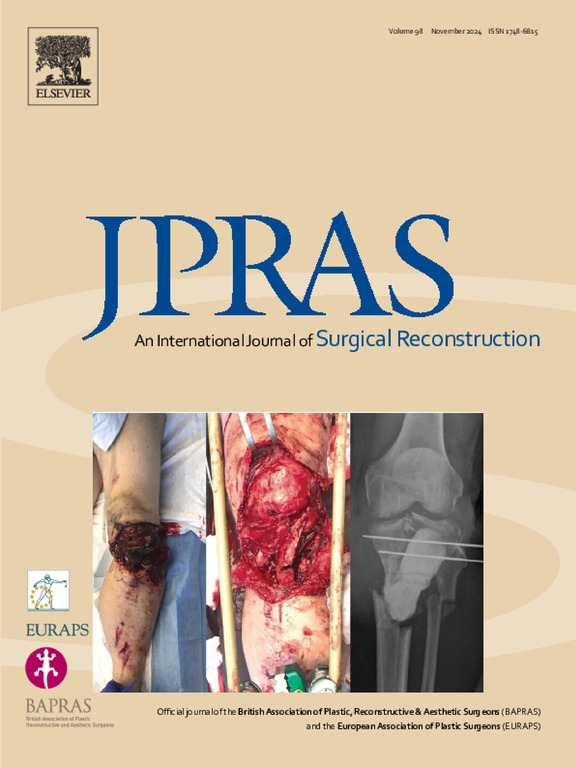Comparison of 3D surface and landmark-based analysis methods: The reliability and efficiency in determining asymmetry after facial palsy
IF 2
3区 医学
Q2 SURGERY
Journal of Plastic Reconstructive and Aesthetic Surgery
Pub Date : 2025-02-27
DOI:10.1016/j.bjps.2025.02.049
引用次数: 0
Abstract
Background
Our study sought answers on the reliability and sensitivity of landmark and 3D surface-based methods in detecting facial asymmetry.
Methods
Asymmetry analysis was performed using anatomical landmarks and surfaces from data obtained with a 3D scanner, and the amount of deviation was calculated according to the opposite half of the face. Resting, eyebrow-raising, eye closure, showing teeth, and whistling facial expressions were evaluated. The intraclass correlation coefficient (ICC) was used to calculate the method's reliability, and sensitivity in detecting asymmetry was tested by comparing healthy subjects and patients with the unpaired t-test. Seventeen patients and 20 healthy volunteers were analyzed.
Results
Intraobserver and interobserver agreement of surface-based analysis ranged from high to excellent in healthy and facial paralysis individuals (ICC 0.77 to 0.99), while landmark-based analyses ranged from moderate to high agreement (ICC 0.60 to 0.91). Furthermore, for the sensitivity in detecting asymmetry, while the landmark-based system could detect statistically significant differences in 2 (eyebrow-raising and showing teeth) of 5 facial expressions (sensitivity = 0.4), the 3D system could detect differences in 5 of 5 (sensitivity = 1) (p < 0.05).
Conclusion
The 3D surface-based analysis method is more sensitive and reliable than the landmark-based method in determining facial asymmetry.
三维曲面与地标分析方法的比较:判定面瘫后不对称性的可靠性和有效性。
背景:我们的研究寻求基于地标和三维表面的方法检测面部不对称的可靠性和敏感性的答案。方法:利用三维扫描仪获得的解剖标志和表面数据进行不对称分析,并根据对侧面部计算偏差量。评估休息、抬眉、闭眼、露出牙齿和吹口哨的面部表情。用类内相关系数(intraclass correlation coefficient, ICC)计算方法的信度,用未配对t检验比较健康受试者和患者对不对称检测的敏感性。对17名患者和20名健康志愿者进行了分析。结果:在健康和面瘫个体中,基于表面分析的观察者内部和观察者之间的一致性从高到优(ICC 0.77至0.99),而基于地标的分析的一致性从中等到高(ICC 0.60至0.91)。此外,在检测不对称的灵敏度上,基于地标的系统在5种面部表情中有2种(抬眉和露牙)的检测差异有统计学意义(灵敏度= 0.4),3D系统在5种面部表情中有5种(灵敏度= 1)的检测差异有统计学意义(p < 0.05)。结论:基于三维表面的分析方法比基于地标的分析方法更灵敏、可靠。
本文章由计算机程序翻译,如有差异,请以英文原文为准。
求助全文
约1分钟内获得全文
求助全文
来源期刊
CiteScore
3.10
自引率
11.10%
发文量
578
审稿时长
3.5 months
期刊介绍:
JPRAS An International Journal of Surgical Reconstruction is one of the world''s leading international journals, covering all the reconstructive and aesthetic aspects of plastic surgery.
The journal presents the latest surgical procedures with audit and outcome studies of new and established techniques in plastic surgery including: cleft lip and palate and other heads and neck surgery, hand surgery, lower limb trauma, burns, skin cancer, breast surgery and aesthetic surgery.

 求助内容:
求助内容: 应助结果提醒方式:
应助结果提醒方式:


